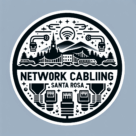What Are the 4 Types of Cable? Understanding the Basics of Network and Electrical Wiring
When setting up a home, office, or commercial network, understanding the different types of cables is essential. Each cable serves a unique purpose — from delivering power to transmitting data — and choosing the right one ensures efficiency, safety, and reliable performance.
So, what are the four main types of cable used today? Let’s break them down in simple terms so you can make informed decisions for your next installation project. Our team of structured cabling experts in Santa Rosa ensures every cable type is properly installed to deliver reliable performance and long-term network efficiency.
1. Coaxial Cable
Coaxial cables, or coax cables, are among the oldest and most commonly used types of wiring. They consist of a central copper conductor surrounded by an insulating layer, a metal shield, and an outer plastic jacket.
What they’re used for:
- Cable television (CATV) connections
- Internet modems (especially in older setups)
- CCTV and security camera systems
- Satellite and antenna signals
Advantages:
- Excellent signal protection from interference
- Reliable over long distances
- Durable and easy to install
Even though newer technologies like fiber optics are becoming more popular, coaxial cables remain a solid choice for many video and broadband applications.
2. Twisted Pair Cable
Twisted pair cables are widely used in both residential and commercial network installations. They contain pairs of insulated copper wires twisted together to reduce electromagnetic interference.
There are two main types:
- Unshielded Twisted Pair (UTP): Commonly used for Ethernet networking (like CAT5e, CAT6, and CAT6a cables).
- Shielded Twisted Pair (STP): Includes an extra shield to protect against interference in high-noise environments.
What they’re used for:
- Internet and data networks
- Telephone systems
- LAN (Local Area Network) connections
Advantages:
- Cost-effective
- Easy to install and maintain
- Supports high-speed data transmission
If you’ve ever plugged a computer into a router using an Ethernet cable, you’ve used a twisted pair cable — the backbone of most modern networks.
3. Fiber Optic Cable
Fiber optic cables are the future of high-speed data transmission. Instead of using copper conductors, these cables use thin strands of glass or plastic fibers to transmit data as light signals.
What they’re used for:
- Internet backbone connections
- Data centers and enterprise networks
- Long-distance telecommunications
- Security and surveillance systems
Advantages:
- Ultra-fast speeds (up to 100 Gbps and beyond)
- Immune to electromagnetic interference
- Can transmit data over much longer distances than copper cables
- Higher security, as data is harder to tap or intercept
Fiber optics are especially popular in California’s expanding smart buildings, data centers, and high-tech industries where performance and reliability are non-negotiable.
4. Power Cable
Power cables are designed to transmit electrical energy from one point to another. They’re essential for safely delivering power to homes, offices, and industrial systems.
What they’re used for:
- Electrical wiring in buildings
- Powering appliances and machines
- Industrial and outdoor electrical systems
Types of power cables include:
- Armored cables (AC): Durable and suitable for underground or outdoor use.
- Non-metallic sheathed cable (NM or Romex): Common in residential wiring.
- Flexible cords: Used for appliances or temporary power connections.
Advantages:
- Safe and reliable current transmission
- Designed for specific voltage and environmental conditions
- Available in various insulation types for indoor or outdoor use
Proper installation and code compliance are key for safety when working with power cables — especially in commercial or industrial settings.
Choosing the Right Cable for Your Project
Selecting the right cable depends on your specific needs:
- For data and internet: Choose twisted pair (CAT6 or CAT6a) or fiber optic.
- For video and television: Go with coaxial.
- For electrical power: Use approved power cables rated for your voltage and environment.
If you’re unsure, it’s best to consult a licensed cabling or electrical professional who understands building codes, performance standards, and safety requirements in your area.
Why Professional Installation Matters
A cable is only as good as its installation. Professional installers ensure:
- Proper cable routing and termination
- Compliance with local electrical and fire codes
- Reduced interference and signal loss
- Reliable testing and certification for performance
Whether you’re upgrading your office network or wiring a new property, professional installation guarantees safety, efficiency, and long-term reliability. Among these, some specialty cables are designed for specific applications. For example, find out what a 2.5 mm cable is used for in both electrical and data setups.
Upgrade Your Cabling System Today
Cables are the hidden foundation of every connected system — from internet and phone lines to lighting and security. Understanding the four main types of cables helps you make smarter choices for speed, safety, and performance.
If you’re planning a cabling upgrade or installation, work with a certified professional who can design and install a system tailored to your needs.
A properly wired network today means fewer problems and better performance tomorrow.
